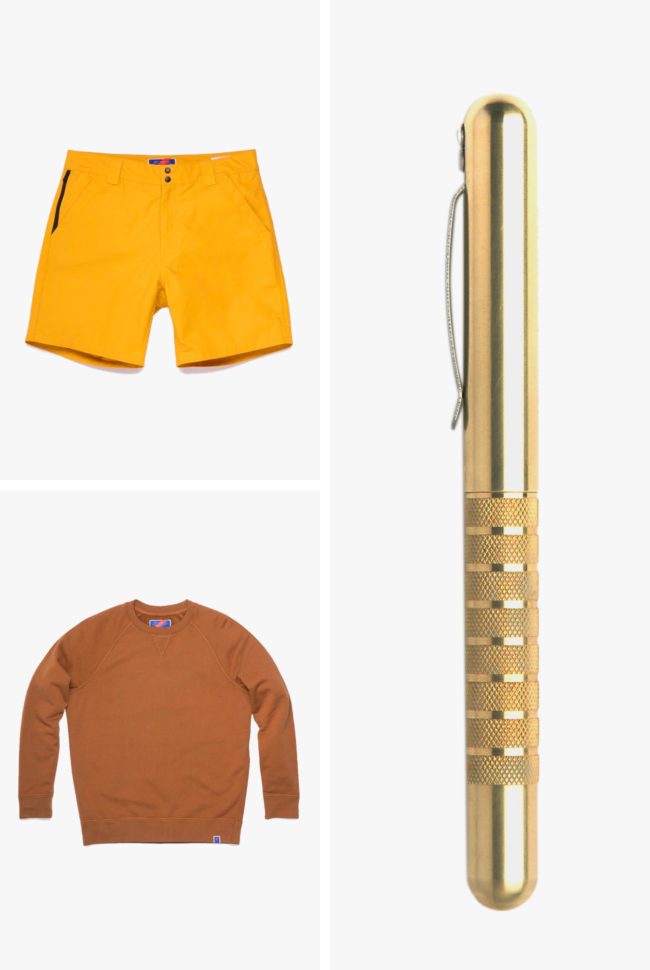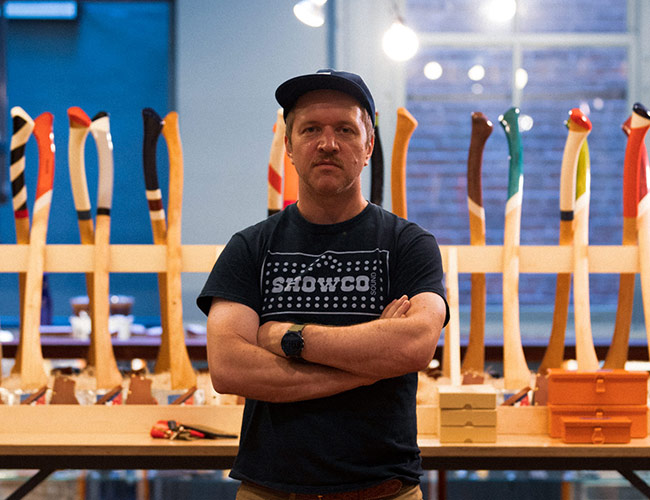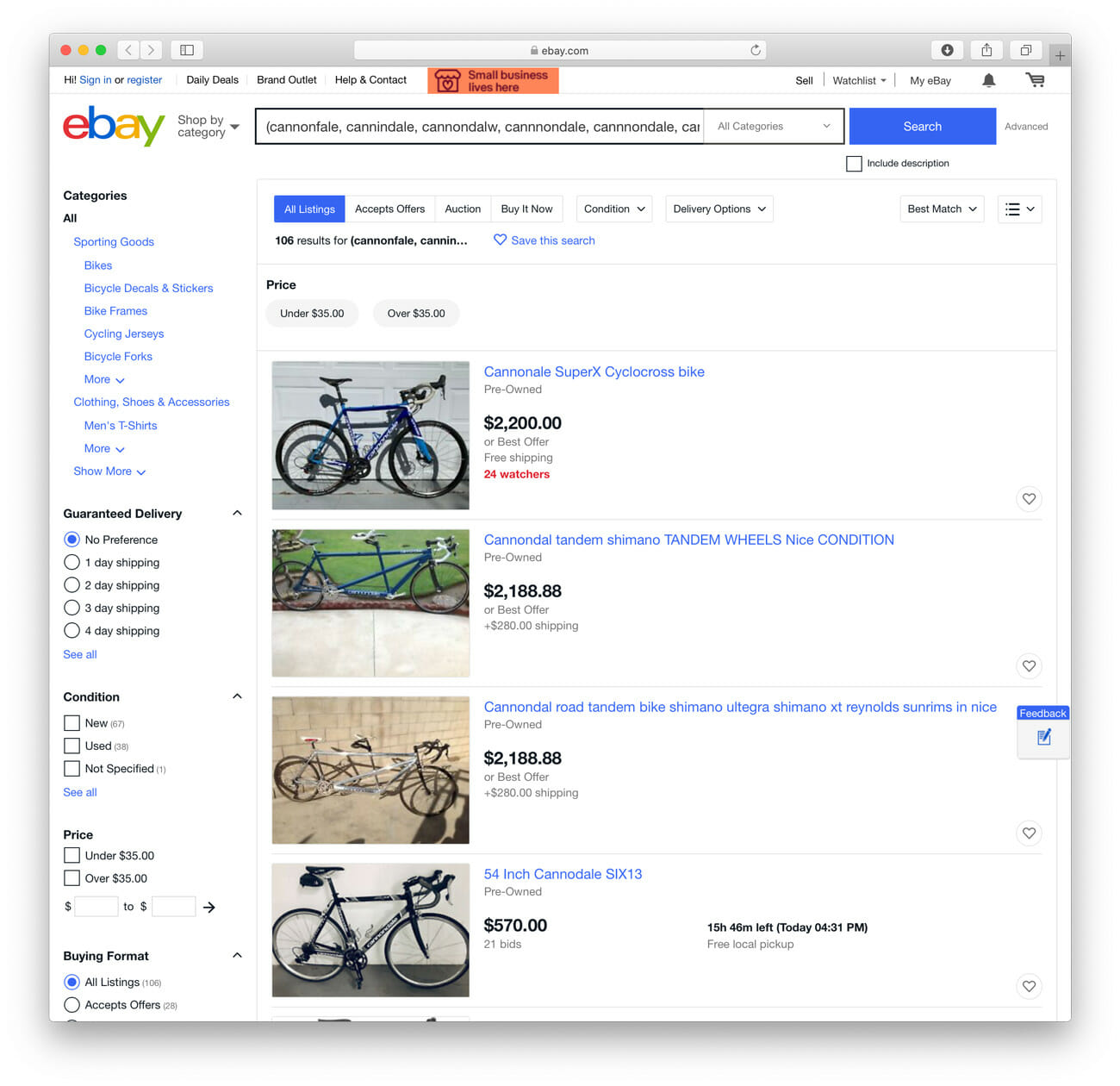If you’re familiar with Best Made Co., it’s likely that you know its axes. They’re the big, two-handed ones made (proudly) in America of steel and hickory; the ones with the painted handles. They were the company’s first product back before Best Made was a company at all. Back then it was just a guy named Peter Buchanan-Smith who, despite a very successful career as a designer in New York City — a list of clients and bosses includes Isaac Mizrahi, David Byrne, Brian Eno and the band Wilco — felt stymied in 2009 by a freshly-tanked economy. Instead of spinning his wheels drumming up more work, he walked into his workshop and started to tinker.
Buchanan-Smith cobbled together a handful of objects, but the one that came out with the most flourish was the axe. “It’s something that’s powerful in every sense, literally and emotionally. It’s the oldest tool known to humankind; it’s this link to the millennia; it’s a tool that’s embedded in our DNA,” he says. It’d be easy to criticize this talk as overly romantic, and many have accused his axes of being pricey fodder for hipsters who might never swing them through a log, but there’s nothing in his voice or countenance that betrays any overindulgence in the thing he’s made. It’s still an axe.
Best Made has sold a lot of axes, but Buchanan-Smith never had any intention of creating an axe company. “It was to be the next great American outfitter-slash-lifestyle brand,” he says, an L.L.Bean for a contemporary lifestyle. From axes, he moved on to items like a first aid kit, a wool beanie and a Japanese-style hatchet. He describes the branching-out as filling in a blank periodic table of elements, where the axe is positioned in the upper left corner as atomic number one, the base for everything else to come.
The chart’s beginning to fill in. Today, Best Made Co. sells pocket knives, trousers, canvas totes, enamel cookware, thermometers and more — its website feels like the digital version of a dry goods supply. Then there are the limited-edition products that Best Made has created in collaboration with its new parent company, Bolt Threads, which is working to make synthetic spider silk a viable material for manufacturing. Spider silk is a Holy Grail of sorts that’s highly sought-after because of its strength to weight ratio; Bolt Threads has managed to make its faux arachnid thread, but the process is still complicated to bring to scale. For that reason, it’s only been used in very limited batches of Best Made products, starting with a spider silk version of its Cap of Courage beanie.
Best Made Co. achieves a high level of cohesion in such an array of items by being deliberate, and the word describes Buchanan-Smith. He genuinely wants to make the best things. Even the things that he carries in his pockets — a wallet, a pocket knife, a pen — are carefully considered and offer their own stories and insights. Story is important. It’s the basis for everything. It’s how he discovered the axe, and it guides a newly-reconsidered line of apparel; it’s the unbroken thread in Buchanan-Smith’s career as a designer and creator.

Photo: Best Made Co.
Q: How does story play a role in discovering new products? Is there always a focus on story?
A: Storytelling is not just a matter of romance, it’s really stories that speak to the function and the utility and our love of these products. The axe is such an incredible hero product in that sense, the history and the lore of it has so much to it, but it’s also what the customer does with the tool and the stories that they in turn create. I always felt like we’d sell an axe and we give it a name and that’s like the title of the book — from there it’s up to the customer to write the story and put that tool to good use.
Q: Say someone buys the axe just because it’s beautiful, to hang it above their mantle, and the tool becomes a decoration. Is that still a story?
A: Look, to me the perfect scenario is someone buys an axe, they go use it, then they take it home and put it on their mantle. But to be honest, we don’t all have time or the ability to be out there chopping wood all day. For me, the axe is also this really beautiful window into a place that we want to be, and that’s important. It’s always going to be there to be used and you never know when you’ll have to use it, and that in itself is reassuring. You can’t do that with a painting or a photograph.
Q: When you were expanding was there a reputation of the axe that you had to meet or grow beyond?
A: We became the axe guys very early on and there’s nothing I’m more proud of. Once we started releasing other products it quickly started to gel. That was so much of the impetus, to not be just a destination for axes but also for amazing content and stories. We weren’t living in the shadow of the axe; it was the perfect perch for us, this amazing first statement. “Best Made is here, here’s what we stand for.”
Q: Have you ever felt any stigma against the axe or the brand?
A: I think if you ask that of any brand there are people who like it and people who don’t. The axe is an evocative tool, there are people who actually think it’s scary. It’s a serious thing — this is a tool that you can hurt yourself with, it’s not for everyone. I think that’s an acceptable thing. The fact that we painted the axes attracted a fair share of critics but again, once we were able to build out that line and show the world that we had more to say that kind of put an end to it.
Q: Did that have an impact on you?
A: You want everyone, especially when you’re young and vulnerable as a company, to love your product. You realize that that’s an impossible proposition. It goes back to “be optimistic,” and one of the reasons I latched onto that spirit is that I’ve only got so much time and energy to put into this so I’m going to focus on the people that really appreciate it. That was an early lesson that’s remained very valuable.

Photo: Jarry Troung
Q: How have things changed with Best Made since expanding from one product into an entire store’s worth of goods?
A: I still think that the core tenants of the brand have not changed and that is a fundamental sign of success. I think that the business itself has changed dramatically, we’ve grown so much. To think that in less than ten years we have built a team of almost 40 strong, that we have stores in LA and in New York. We’re looking forward to this fall especially. We have our first truly cohesive line of apparel that’s firing on all cylinders. I’m talking about apparel that is as effective as the first tools that we released. Jackets that keep you dry and warm; we’re incorporating technology that can go head-to-head with the best of them, like Arc’teryx, Patagonia, The North Face.
Q: What about the changes in your role? You were literally building things in your workshop, what’s your role like now?
A: Before I started Best Made, I spent a lot of time working with people like Wilco or David Byrne or Maira Kalman or Isaac Mizrahi, helping them develop their brands. Stopping that and channeling all my energy into a tiny little workshop that started with 12 axes was, on the one hand, so refreshing and such a necessary step but on the other hand it was temporary and I always knew that. The goal was not to have a tiny axe workshop, it was to build an influential lifestyle brand. It’s not always easy to shed your hat, especially the ones that are most comfortable and that you’re used to wearing. For me the tradeoff is that I get to see more and more people around the world who are more and more devoted to and inspired by this thing that I’ve built.
Q: Quality is at the core of Best Made and its products. How do you define that word?
A: Quality is quite often in the details of whatever it is that you’re assessing. As with an axe that or a waterproof down parka, it’s when you pick that thing up and use it when quality speaks for itself. The voice of the brand, of the salesmen, that all flies out the window and quality becomes real.
Q: If utility is wrapped up in quality, how do you create it in items that aren’t tools, like apparel?
A: If an axe is not sharp you can’t cut wood, if a jacket isn’t waterproof you’re going to get wet. There’s fundamental utility that spans all of our products. The interesting thing about apparel is that there’s this, I don’t know what you call it, a comfort level; that feeling when you wake up in the morning and get dressed to go to work. Utility isn’t necessarily the thing that’s at the front of your mind, and instead, it’s what’s going to make you feel confident and comfortable. There are a lot of questions you may subconsciously be asking yourself as you prepare to go about your day. Even if it’s just a Best Made chambray shirt, I like to think we’re really equipping our customer with that sense of confidence. It goes back to quality — if you believe in the product that you buy, in the shirt that you’re wearing or the axe that you use, and you believe in these things because they are true quality, that’s inspiring, that’s a nice way to live your life.
Q: Is there a piece of apparel in the new line that’s analogous to the axe in its quality?
A: The Down Parka. That is as powerful a tool in a piece of apparel that we’ve ever created. I was recently down in Patagonia in the dead of winter — there was at least a foot of snow if not more, high winds — I couldn’t take that jacket off. It’s so incredibly warm but also what I appreciated about wearing it, often with garments that are really warm they demand something in return from you — they’re either really heavy or they’re itchy or they’re hard to get on and off. For a big parka this jacket is exceptionally light and it’s also waterproof.
Q: How do you think of the innovation happening at your parent company, Bolt Threads, next to something like the axe, which was mankind’s first tool?
A: Bolt is exceptionally innovative but they’re still working off of timeless things. Think of spider silk or mycelium — as a starting point it doesn’t get more timeless than that. It illustrates so much of a direction that we’re heading in: we’re not trying to reinvent the wheel; we’re working off of designs and functionalities that are truly timeless but we are improving them wherever we can with designs, materials, whatever. That’s where I see the future for us, a balance between something that is timeless and something that is foreign looking and innovative.




